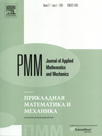 | | Journal of Applied
Mathematics and Mechanics
Russian Academy of Sciences | | Founded
in January 1936
(Translated from 1958)
Issued 6 times a year
ISSN 0021-8928
(print version) |
Archive of Issues
| Total articles in the database: | | 10482 |
| In Russian (ΟΜΜ): | | 9683
|
| In English (J. Appl. Math. Mech.): | | 799 |
|
| << Previous article | Volume 73, Issue 2 / 2009 | Next article >> |
| A.P. Ivanov, "A dynamically consistent model of the contact stresses in the plane motion of a rigid body," J. Appl. Math. Mech. 73 (2), 134-144 (2009) |
| Year |
2009 |
Volume |
73 |
Issue |
2 |
Pages |
134-144 |
| Title |
A dynamically consistent model of the contact stresses in the plane motion of a rigid body |
| Author(s) |
A.P. Ivanov (Moscow, Russia, apivanov@orc.ru) |
| Abstract |
The problem of determining dry friction forces in the case of the motion of a rigid body with a plane base over a rough surface is discussed. In view of the dependence of the friction forces on the normal load, the solution of this problem involves constructing a model of the contact stresses. The contact conditions impose three independent constraints on the kinematic characteristics, and the model must therefore include three free parameters, which are determined from these conditions at each instant. When the body is supported at three points, these parameters (for which the normal stresses can be taken) completely determine the model, while indeterminacy arises in the case of a larger number of contact points and, in order to remove this, certain physical hypotheses have to be accepted. It is shown that contact models consistent with the dynamics possess certain new qualitative properties compared with the traditional quasi-static models in which the type of motion of the body is not taken into account. In particular, a dependence of the principal vector and principal moment of the friction forces on the direction of sliding or pivoting of the body, as well as on the magnitude of the angular velocity, is possible. |
| Received |
02 November 2008 |
| Link to Fulltext |
|
| << Previous article | Volume 73, Issue 2 / 2009 | Next article >> |
|
 If you find a misprint on a webpage, please help us correct it promptly - just highlight and press Ctrl+Enter If you find a misprint on a webpage, please help us correct it promptly - just highlight and press Ctrl+Enter
|
|

 Russian
Russian  English
English